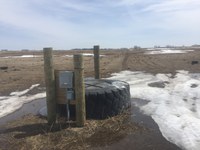Water Development Worth the Investment
(Click the image below to view a high-resolution image that can be downloaded)
Last year’s drought dried up many ponds and dugouts or compromised the quality of the water in them, forcing North Dakota livestock producers to haul water or install an alternative water source.
Producers in many counties reported going into the winter of 2017-18 short to very short on available surface water, according to surveys North Dakota State University Extension agents conducted.
“Providing adequate water to livestock is critical for animal health and production,” says Miranda Meehan, NDSU Extension livestock environmental stewardship specialist. “Good-quality water can have a major impact on your cattle’s intake and weight gain.”
Canadian studies have shown the quality of water accessible to livestock is directly tied to the amount of forage they consume. Studies report improved gains by as much as 0.24 pound per day in yearlings and 0.33 pound per day in calves receiving good-quality water.
“Providing good-quality water also can improve herd health,” Meehan says. “Livestock whose primary water sources are ponds and dugouts have a greater risk of contracting illnesses such as giardia, leptospirosis and cyanobacterial poisoning, compared with livestock drinking from a trough.”
Water quality in dams and dugouts can be compromised because drought conditions often result in increases in blue-green algae and elevated levels of sulfates, which have the potential to be toxic.
Installing a water development project can help ensure that livestock have access to good-quality water throughout the grazing season, Meehan says.
In addition to benefiting animal health and performance, installing water development projects can:
- Increase flexibility in producers’ management systems
- Increase grazeable acreage and extend the grazing season
- Allow producers to utilize crop residues and cover crops for forage
- Improve grazing distribution
“Through time, these improvements, combined with appropriate management, have the potential to increase the carrying capacity of your operation, allowing for an increase in herd size and/or increased drought resistance with stockpiled forages,” Meehan says.
Common water developments include troughs, pumps, wells and pipelines. Many cost-share opportunities are available through the Farm Service Agency, Natural Resources Conservation Service, Soil Conservation District or conservation groups for producers installing water developments. To learn more about water development cost-share opportunities, contact your local Natural Resources Conservation Service office, Soil Conservation District or conservation groups.
Also, in response to the 2017 drought, the North Dakota State Water Commission opened the Drought Disaster Livestock Water Supply Program, which will cover up $3,500 of the eligible costs for water development projects.
“To date, the program has approved funding for 512 projects,” program administrator Michael Noone says. “There is $425,000 available to producers in qualifying counties.”
These funds will remain available until the State Water Commission determines drought conditions have eased. For more information on the program, visit https://tinyurl.com/SWCwaterdevelopment.
For more information on livestock water quality issues, check out these NDSU Extension publications:
- “Livestock Water Requirements” - http://tinyurl.com/LivestockWaterRequirements
- “Livestock Water Quality” - http://tinyurl.com/LivestockWater
NDSU Agriculture Communication - April 25, 2018
| Source: | Miranda Meehan, 701-231-7683, miranda.meehan@ndsu.edu |
|---|---|
| Editor: | Ellen Crawford, 701-231-5391, ellen.crawford@ndsu.edu |


